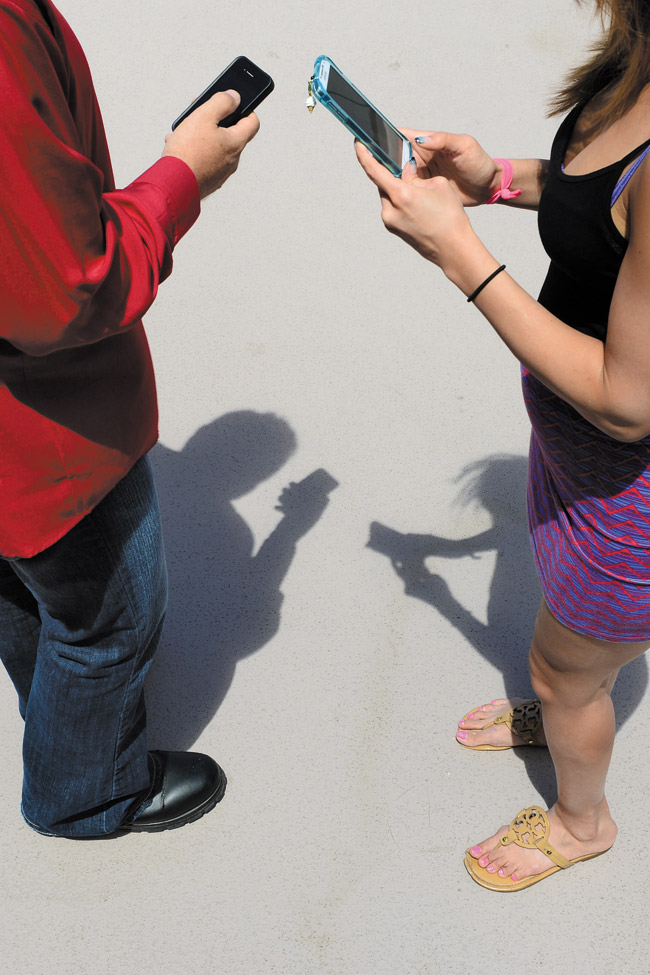Drawing A Line With Social Media

Alone together: People not only talk on their smartphones, but practically live their lives on them | Nathalie Walker photo
Scene: A woman and her companion take their seats in a restaurant known for its popularity among trendsetters and social media bloggers. At last, she thinks, an opportunity to reconnect, to chat, to laugh and tell stories – just like they used to in the heyday of their long friendship. She leans forward to speak, then pauses. Her companion has whipped out her phone and peers at it, enthralled.
“Important call?” the woman asks.
“Oh, just checking Facebook.” The woman sits back and waits.
And waits.
And waits.
End scene.
A few years ago I included in a column a description of an uncomfortable dinner with a friend who couldn’t stop talking on her cellphone. It was way, way back in 2006 when I wrote, “I’ve had it happen to me. Out having dinner with a friend when her cell phone rings. Instead of saying, ‘I’ll call you back later,’ she talks. And I sit. At first you think it’s OK, then you wonder how she can ignore the fact that she has turned you into a potted plant.”
Oh, how things have changed – and not for the better. It is far worse, in fact, because people don’t just talk on their phones anymore, they practically live their lives on them.
They text. They tweet. They Facebook (yes, it’s a verb now). They check emails and write them. They surf the net and Google stuff. They make reservations. They take pictures. They navigate. They play games. They read books.
Have I missed anything?
You name it, people do it on their phones. I am including myself in this – I do all of the above, and I love it.
But I do insist on drawing a line. And the line is fluid – it happens to be wherever human interaction is – or should be – expected.
Take my little scene setter in the restaurant. My son and I had lunch recently at a popular restaurant in Waikiki. We were in a section that included about seven tables and booths, all filled.
I looked around. To my left: a woman and a teenage girl. Girl doing something on the phone, woman sitting back looking bored.
To my right: two women, about equal in age. Both tapping on their little screens. No talking.
Directly ahead: family of four. Mom and Dad talking to each other, two kids staring at their phones.
Next to the family: two women, who both snap pictures of their food. OK, I do that. But then I put my phone away, as these two ladies did. Hooray.
When did eating out with friends or family become such a solitary experience?
This isn’t a new phenomenon, but it’s one that has somehow crept way past the line of acceptability. Author Sherry Turkle addressed it in her 2011 book, Alone Together: Why We Expect More from Technology and Less from Each Other. She, and many others, point out that technology promises the opportunity and the toys to connect, and often delivers on that promise. I have interacted with people on Twitter and on forums whom I later met in “real life” and who have become true and lasting friends. I have reconnected with people and family on Facebook. There is a way to use this technology to enhance our lives.
But it also offers us more ways to disconnect and to be isolated, even in the company of people we know. Often what we end up with is simply a simulation of human interaction.
It feels good to have dozens or even hundreds of “likes” on Facebook, but don’t mistake it for reality. Don’t get seduced into thinking they represent the entirety of your world.
If you have children, I believe it’s even more critical to set the rules early on. Think about it – they are inundated with technology. It’s up to us to teach them how to balance their intertwined worlds, how to set priorities. They won’t know unless you teach them what’s important.
We have an understanding in our little family – that we pay attention to each other during dinner at home and in restaurants. I had to tell my son he could not stick the earbuds in his ears whenever we drove somewhere (“I’m not a chauffeur!”).
We’re still working out individual situations and setting guidelines. I don’t think we’ll ever be able to stop as long as technology keeps changing. We either change with it or risk being left behind – and alone.





